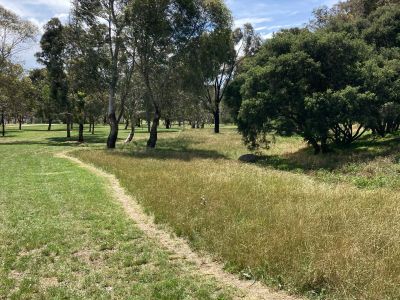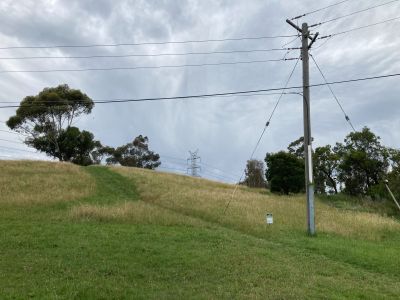What are we doing?
Merri-bek is conducting a trial to reduce how often we mow in small sections of some parks.
In the UK and Europe, reducing mowing in parks to support biodiversity is a common practice. This hasn’t yet been tested in Australia.
In this trial we are testing both the management implications and biodiversity outcomes of reduced mowing. We are also investigating what the community thinks of reducing mowing in certain areas.
After 12 months of collecting data, we will review the outcomes of each site. If successful, we will continue with reduced mowing.
A biodiversity mowing trial is an action item of the Merri-bek Nature Plan.
New Trial Sites for 2025
We are expanding our trial to some new sites in 2025 and would love to gather your thoughts and feedback.
A total of 11 sites will be marked out as biodiversity mowing plots this spring, including new ones at:
- Jones Park, Brunswick East
- Clifton Park, Brunswick
- Merri Creek Parklands, Fawkner
- Edgars Creek Parklands, Coburg North
- Denzil Don Reserve, Brunswick West
If you are interested in sharing your thoughts, please provide feedback by scrolling down to the bottom of the page. 🌿🐝
Share your thoughts
- Share your experience of a biodiversity mowing site below
- Call us on 9240 1111 to let us know your feedback
For this project, you can provide feedback on the locations chosen, and share your experience of the site. This will inform how we proceed after the trial.
About the project
Biodiversity is in decline, what can we do?
A healthy ecosystem is a diverse one, with lots of different plants and animals. Unfortunately, the variety of living things in cities is declining. Cities need to do more to protect biodiversity.
Changing the way we mow the grass in our parks can help.
If we mow less often, more plants can flower. This provides food and habitat for bees, butterflies and other insects.
The importance of insects
Insects play a critical role in ecosystem function:
- Pollination
- Pest regulation
- Providing food for other animals
- Nutrient cycling for healthy soils
Merri-bek’s Nature Plan notes the critical role played by insects as part of the municipality’s biodiversity, and of the potential for small-scale interventions to enhance insect habitat.
Examples of biodiversity mowing
Proposed trial sites and approx. area
Biodiversity is the variety of living things in an ecosystem. When there are lots of different plants, animals, insects and fungi, the ecosystem is healthier.
Higher biodiversity landscapes can provide many benefits to people, including mental and physical health benefits.
Snakes are part of Merri-bek’s biodiversity. They have always been present in certain areas where they can find prey such as frogs, reptiles and rodents.
Snake bites are very uncommon. Nevertheless, we advise exercising caution around areas of long grass during spring and summer when snakes are active, and to keep dogs on-leash in areas of long grass.
If you do see a snake, remember to keep calm and move away slowly.
We are maintaining a short mown buffer around all test sites where visibility for snakes will be best.
We have conducted a risk assessment process and continue to uphold our responsibilities under the Metropolitan Fire Brigades Act 1958, and undertake this trial in accordance with our Municipal Fire Management Plan.
Trial areas are all within low fire risk rated areas, and will be mown at least once prior to summer to reduce fuel loads and the risk of grass fires.
We will continue to monitor fuel loads and weather conditions throughout the trial.
Reducing mowing should allow more plant species to grow. It’s likely that most of these will be exotic (non-native) plants, including weeds. Exotic plants and weeds can still provide valuable habitat and food for native insects.
We will be looking at the abundance of weeds as part of the trial and monitoring the surrounding garden areas for increased weeds.
We have avoided situating trial sites close to sensitive vegetation to minimise risk of weeds spreading.
Trial areas will be monitored for weeds and mown to intercept seed-set where possible. We will continue to respond to environmental weeds as needed.
So far, the trial has looked at changing our management practices and gathering community feedback.
The next step is to develop a framework for collecting data. We'll work with ecologists and entomologists to collect and analyse data. These experts will guide us on how to proceed.
A successful trial will provide useful data on how a reduction in mowing affects the diversity and abundance of insects and plants.
The continuation of reduced mowing will depend on the biodiversity outcomes and public feedback.
Similar trials are happening elsewhere
- Grasslands Maintenance Trial Boosts Biodiversity (Perth and Kinross Council, UK)
- Lawn-mowing reduction can help wildlife, says study. (The Guardian)
- Mowing urban lawns less intensely increases biodiversity, saves money and reduces pests (Science Daily)
- Hamilton City Council trials no-mow meadows to boost biodiversity, cut emissions (Waikato Times)
- The Wild Initiative (Tree Advocates, Auckland)
What happens next
We'll collate and review the responses we receive. This will help us with future site selection for biodiversity mowing sites.
Contact Us
Phone
+61 3 9240 1111
Email
engagement@merri-bek.vic.gov.au
National relay service
133 677
(ask for 03 9240 1111)









